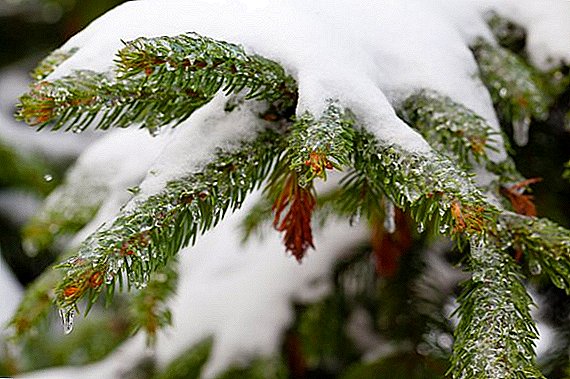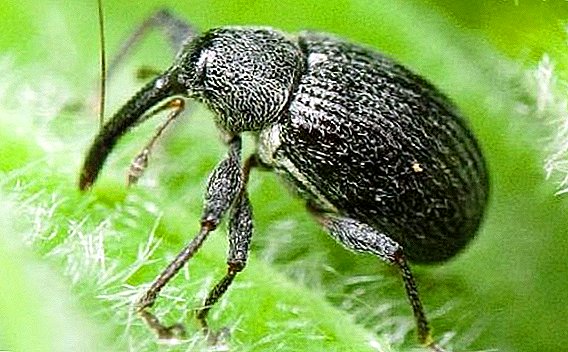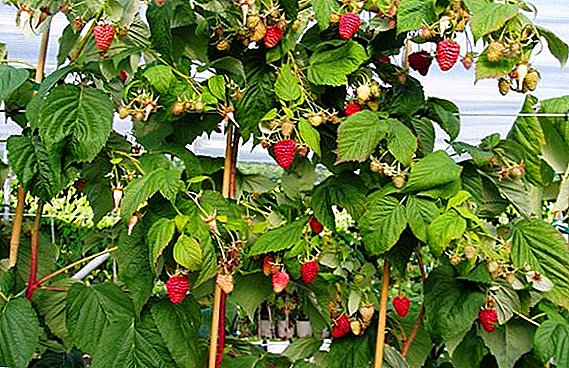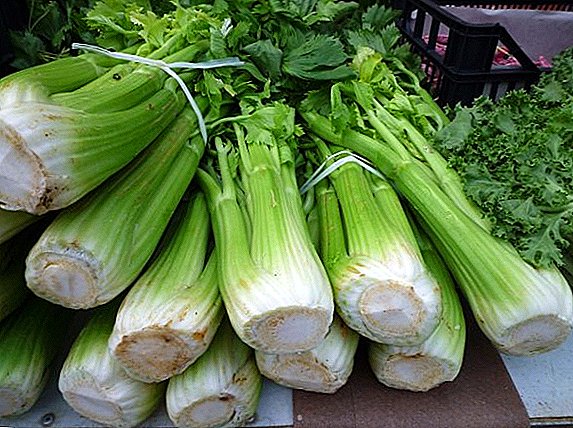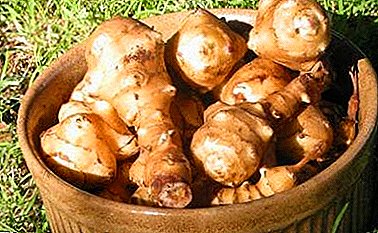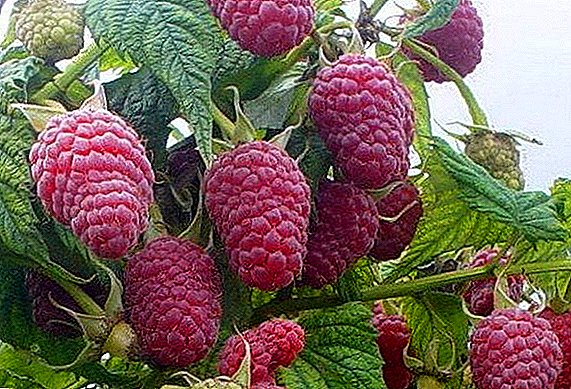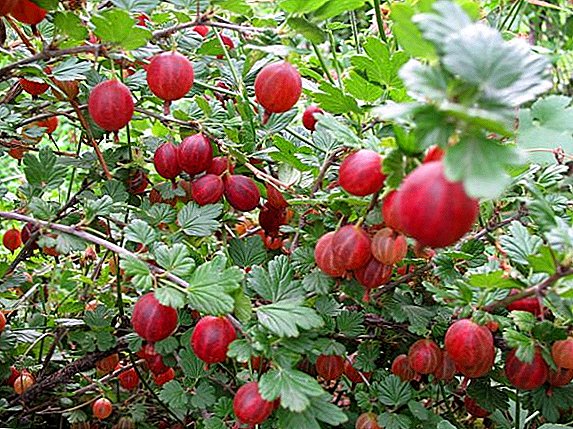 Gooseberry is a species that belongs to the genus Smorodinovye family Gooseberry. The plant is originally from Africa and also grows wild in southern Europe, the Caucasus, Asia and America.
Gooseberry is a species that belongs to the genus Smorodinovye family Gooseberry. The plant is originally from Africa and also grows wild in southern Europe, the Caucasus, Asia and America.
Did you know? Gooseberry in Europe became famous in the 16th century, and in the 17th it became one of the most popular berries in England. Since that time, selection work began to improve gooseberry hybrids. It was possible to obtain mildew resistant varieties.
Gooseberry is a small shrub up to 120 cm, with brown flaking bark, which is covered with leaf-borne spines. The leaves are rounded, slightly elongated, with denticles, inexpressive, characteristic of thorny shrubs.
 The gooseberry blooms in May with red-green axillary flowers. Gooseberry berries spherical and round, up to 12 mm (there are varieties with fruits up to 40 mm), covered with needle-like soft scales. On the berries clearly stand veins of green, red and white shades. The fruits ripen in July and August.
The gooseberry blooms in May with red-green axillary flowers. Gooseberry berries spherical and round, up to 12 mm (there are varieties with fruits up to 40 mm), covered with needle-like soft scales. On the berries clearly stand veins of green, red and white shades. The fruits ripen in July and August.
Gooseberry fruit is healthy and tasty. They contain organic acids, tannins, metal salts and vitamins. The plant is self-fertile: if you have one shrub in your garden, the gooseberry will still bear fruit, attracting pollinating insects.
Did you know? We call gooseberries "northern grapes".
Everything you need to know about planting gooseberries
When to plant gooseberries
Gooseberry can be planted in the fall and spring. Most gardeners prefer to plant gooseberries in the autumn, explaining that after planting, gooseberry bushes have time to form strong roots and prepare for winter.
When planting a gooseberry, consider all its characteristics and needs. The roots of the "northern grapes" are long, so you should not plant it in the valley, it can become infected with fungal diseases.
Gooseberry is best planted on a sunny plain or hill. This area should be protected from cold winds from the north and east. The soil should be neutral or with low acidity. Loamy, sandy, sandy and clayey soils are suitable for him.
Planting in the fall
 Planting gooseberries in autumn is a matter of some preparations. You need, first of all, to clean the area from weeds and debris; since the bush is prickly, it will be difficult for you to weed afterwards. Then, the already cleaned area should be dug and removed the roots of weeds, to level the ground with a rake, breaking the lumps.
Planting gooseberries in autumn is a matter of some preparations. You need, first of all, to clean the area from weeds and debris; since the bush is prickly, it will be difficult for you to weed afterwards. Then, the already cleaned area should be dug and removed the roots of weeds, to level the ground with a rake, breaking the lumps.
Many gardeners are advised to dig a hole with a depth and width up to 50 cm for 2-3 weeks before planting, in order for the earth to settle. The upper, most fertile soil layer should be removed and put aside; the same operation should be done with the lower infertile soil layer. Next, prepare the fertilizer for planting gooseberries: in the fertile soil, add 10 kg of decomposed humus, 50 g of superphosphate and potassium sulfate. This fertilized land plant should be enough for several years.
Important! If the area is clay soil, then when preparing the soil for gooseberries need to add a bucket of river sand.
If you plant several plants, then the distance between them should be at least a meter, between rows - up to 3 m.
One-year-old saplings with roots 25-30 cm long are well suited for planting. The ground part of the plant should consist of several strong branches. Before planting a plant, its roots should be soaked in a solution of any fertilizer that stimulates growth.
Young bushes of a plant should be planted at an angle so that the root neck is below the level of the soil; the roots must be well straightened. Pour the earth piecemeal, each layer being tamped with a layer of peat and humus.
Landing in spring
 Planting gooseberry in the spring is no different from autumn. If you are thinking about planting gooseberries in spring or autumn, most gardeners recommend doing this in the fall. Planted in the autumn, the gooseberry will take root better, the shoots will be stronger and stronger than the bushes planted in the spring.
Planting gooseberry in the spring is no different from autumn. If you are thinking about planting gooseberries in spring or autumn, most gardeners recommend doing this in the fall. Planted in the autumn, the gooseberry will take root better, the shoots will be stronger and stronger than the bushes planted in the spring.
Did you know? Gooseberry begins to bear fruit only in the third or fourth year, and its fruiting can last up to 15 years.
What should be the place for landing
Gooseberry - light-loving plant. Therefore, it should be planted in sunny places.
Does not like overmoistening (begin to rot roots) and tolerates drought well. Gooseberries need to be planted in places with low groundwater levels, at least 1.5 m from the surface. The plant needs planting in a place where you and your family members will be able to take care of it unhindered. Pruning a plant should also not be a problem for you.
If you have little space on the site, then The plant can be planted between fruit trees, but at a distance of at least 2 meters. You can also land along the fence - no less than 1.5 meters.
Gooseberry does not like highly oxidized soil. The acidity of the soil should not exceed 6 Ph, if the level is higher, then lime should be added to the soil - 200 g per 1 square meter. m
Soil preparation and planting scheme "northern grapes"
 Gooseberry is not demanding on the soil. In addition to acidic soils, also does not like very wet and cold land. If the plant is grown on clay soil, then it is necessary to carry out frequent loosening, and in sandy, sandy loam - to make fertilizer.
Gooseberry is not demanding on the soil. In addition to acidic soils, also does not like very wet and cold land. If the plant is grown on clay soil, then it is necessary to carry out frequent loosening, and in sandy, sandy loam - to make fertilizer.
After carefully cleaning the soil for planting, you need to remember to add fertilizer. Knead fertile soil with manure, humus, compost in the ratio of 4 kg per 1 sq. Km. m plot. If the soil is poor, then you need to increase the amount of organic fertilizer. In such cases, additional urea (20-30 g), superphosphate (50 g), potassium chloride (15-20 g) should be added.
For greater effect, when the soil is poor, organic fertilizers are applied directly to the planting pit. With sandy soil, clay is laid at the bottom of the pit (up to 7 cm), with clay - river sand.
Rules for the care of gooseberries
How to care for gooseberries in spring
In the gooseberry, the growing season begins in early spring. The plant blooms in May, and the fruits begin to ripen in late June and until August.
In the spring, before budding, in the soil under the gooseberry need to make mineral fertilizers - potassium, phosphorus, nitrogen. During the period when the buds open, feed the plant with manure or compost (12 kg per bush). At this time, it is also necessary to treat the gooseberry with preparations from various insects.
 Against aphids, moths, sawfly apply soap solution with ash - 10 liters of water, 50 g of soap and 40 g of sifted ash to insist day. This solution is sprayed on the plant in the spring, during the bud period.
Against aphids, moths, sawfly apply soap solution with ash - 10 liters of water, 50 g of soap and 40 g of sifted ash to insist day. This solution is sprayed on the plant in the spring, during the bud period.
It is believed that For fruit shrubs, the best time for pruning is early spring, but spring pruning of the gooseberry can be fatal for its future harvest. The plant wakes up earlier than others: the snow has not yet melted, and the gooseberry already dissolves the buds. It is better to cut gooseberries in late autumn, when the plant is ready for winter. If you need seedlings, then you need to loosen the ground under the bush, apply fertilizer, make small grooves and fill them with water. Then in these grooves lay 2 sprigs of gooseberry, carefully crushing them in a moist soil and attaching to the ground with hooks. In the fall you will receive shaped seedlings that need to be divided into parts and planted.
Important! The young gooseberry (two-year-old) requires careful care in early spring, it requires frequent fertilizing and moderate watering.
What to do in the summer
In the summer, you need to periodically weed the plant, loosen the ground near the bush (up to 10 cm deep) and water it after each loosening. "Northern grapes" tolerates drought well, but during such periods it pulls moisture from its fruits, leaves and shoots, therefore, in order for the plant not to deplete its resources, it is necessary to water it well during drought.
Important!Gooseberries need to be watered at the root, as it can get powdery mildew.
The gooseberry, in the period when it begins to bear fruit, needs light portions of organic fertilizers. Mix 1: 1 compost, peat or manure with the ground and stick the mixture under a bush of "northern grapes".
Caring for the gooseberry in the fall
 In early autumn you need to weed gooseberry bushes from weeds, to remove various organic debris that has accumulated over the summer. When the foliage has fallen, it will also be necessary to remove it near the gooseberry and burn it, since pathogens of various diseases can remain in it.
In early autumn you need to weed gooseberry bushes from weeds, to remove various organic debris that has accumulated over the summer. When the foliage has fallen, it will also be necessary to remove it near the gooseberry and burn it, since pathogens of various diseases can remain in it.
Besides, you need to create a soil pillow near the bush, it will protect the plant from pests.
In the autumn, it is necessary to treat the plant with fungicides from rust, powdery mildew, and anthracnose.
It is recommended to carry out a top dressing of a plant during soil digging. Fertilizers and potash fertilizers should be included in the dressing - 30 g of the preparation should be used under each bush. Before the first frost, it is necessary to put humus with peat up to 10 cm thick under the bush.
In late autumn, before the first frost, you need pruning gooseberries This will help in the formation of a fructifying bush and will remove old and damaged branches. After such pruning, up to 6 strong evenly spaced shoots should remain on the bush. This is the basis for a good harvest next year.
In December, when the first snow fell, you need to throw it under the gooseberry to protect against the upcoming frost. If winter promises to be of little snow, then the plant should be covered with agrospan or other similar material.
Gooseberry Breeding
There are several ways to reproduce gooseberry. Each gardener chooses one convenient for him. The most common and popular ones are:

- Reproduction by layering
- Propagation by arcuate layers
- Vertical layering
- Lignified cuttings
- Green cuttings
- Combined cuttings
- Perennial branches
- The division of the bush.
The main rule for such gooseberry breeding is the presence of wet ground for rooting plants.
Harvesting and storage
Harvest time of gooseberry depends on the variety. The peak of the collection falls on July-August. Most of the berries ripen almost simultaneously, so that the harvest can be collected immediately.
There are two stages of gooseberry maturity: technical and consumer. With technical maturity, such fruits are great for cooking jam, compote. They entered their form, and begin to acquire a color corresponding to the variety. But the pulp is still sour.
Consumer maturity - This is when the berry has fully formed, the color of the fruit has become consistent with the variety, the taste is sweet, with mild acidity, the peel crunches under the teeth.
On average, one bush can collect up to 8 kg of berries.
 Storage conditions for gooseberry berries will depend on their degree of maturity. If the berries are ripe, then you need to collect fruits in containers up to 2.5 liters, and they are stored for up to 4 days. Berries with technical maturity can be stored for up to 10 days in a cool room.
Storage conditions for gooseberry berries will depend on their degree of maturity. If the berries are ripe, then you need to collect fruits in containers up to 2.5 liters, and they are stored for up to 4 days. Berries with technical maturity can be stored for up to 10 days in a cool room.
Berries of both types of maturity should be dried and checked for damage. Such berries at zero temperature can be stored for up to 1.5 months. You can increase the shelf life up to 5 months if you freeze the gooseberry berries in plastic bags.
Gooseberry - a plant whose cultivation does not make you problems, and care for him, and even cut off will please the gardener. But truly he will delight you with his juicy berries, and in winter - jam and compotes.


